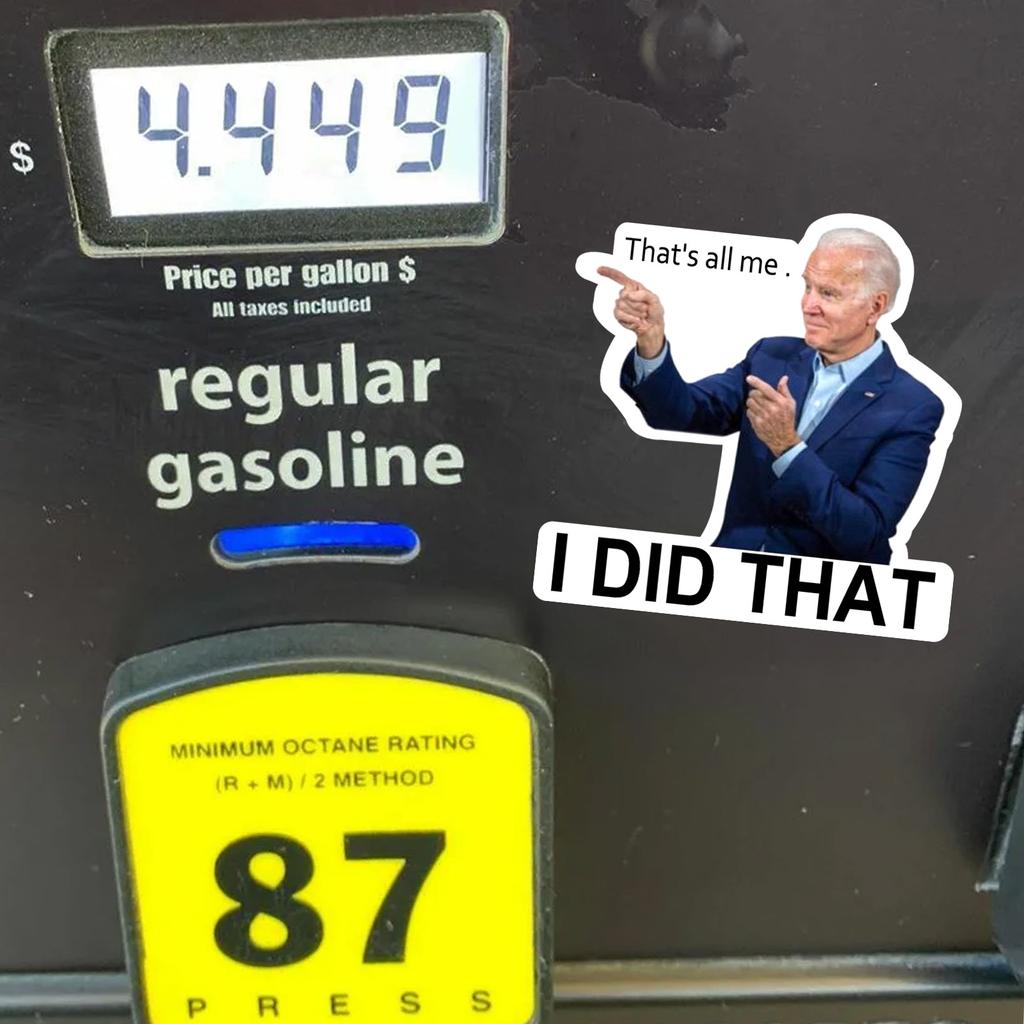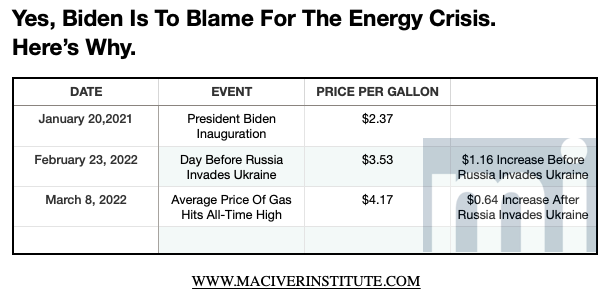 @DanODonnellShow Yes, Biden Is To Blame For The Energy Crisis. For a man who has repeatedly promised to destroy America’s oil industry, it is laughable that he is blaming Putin. https://bit.ly/3MC48CM Click To Tweet
Pres. Biden - No more subsidies for the fossil fuel industry, no more drilling on federal lands, no more drilling, including offshore, no ability for the industry to continue to drill. It ends. https://bit.ly/3MC48CM Click To Tweet
@DanODonnellShow Drilling leases by the thousands are being held up by regulators, and those that aren’t are facing lawsuits from environmental groups who have the tacit approval of the Biden Administration https://bit.ly/3MC48CM Click To Tweet
@DanODonnellShow - Biden needs to abandon his campaign pledge to kill the American energy industry, but even in an energy emergency, Biden is doing everything to avoid increasing domestic oil production. https://bit.ly/3MC48CM Click To Tweet
@DanODonnellShow Yes, Biden Is To Blame For The Energy Crisis. For a man who has repeatedly promised to destroy America’s oil industry, it is laughable that he is blaming Putin. https://bit.ly/3MC48CM Click To Tweet
Pres. Biden - No more subsidies for the fossil fuel industry, no more drilling on federal lands, no more drilling, including offshore, no ability for the industry to continue to drill. It ends. https://bit.ly/3MC48CM Click To Tweet
@DanODonnellShow Drilling leases by the thousands are being held up by regulators, and those that aren’t are facing lawsuits from environmental groups who have the tacit approval of the Biden Administration https://bit.ly/3MC48CM Click To Tweet
@DanODonnellShow - Biden needs to abandon his campaign pledge to kill the American energy industry, but even in an energy emergency, Biden is doing everything to avoid increasing domestic oil production. https://bit.ly/3MC48CM Click To Tweet
By Dan O’Donnell
Exclusive Perspective To MacIver
“What do you think about the price of gas?” a reporter asked President Biden as he arrived in Fort Worth, Texas Tuesday afternoon.
“It’s going to go up,” Biden answered.
“What are you going to do about it?” the reporter followed up.
“Can’t do much right now,” Biden replied. “Russia’s responsible.”
For a President who promised to bring trust and accountability back to the White House, this was a revealing moment. And for a man who has repeatedly promised to destroy America’s oil industry, it is laughable that he is now trying to claim that the buck stops with Vladimir Putin.
On Tuesday, the average price of gas hit an all-time record of $4.17 per gallon, up 21 percent in just a week. The sudden spike is, of course, due to the sudden instability in the global market following Russia’s invasion, but consider this: On January 20, 2021, the day Biden was inaugurated, the average price of gas was $2.37. On February 23, 2022, the day before Russia invaded Ukraine, the average price was $3.53. This means that gas rose $1.16 in the first year of Biden’s term (and in large measure because of Biden’s policies), but only $.064 (so far) because of the war.
And yes, Biden’s policies have made domestic energy production more difficult and less cost-efficient…just as he repeatedly promised he would while campaigning for the presidency.
“Would there be any place for fossil fuels, including coal and fracking, in a Biden Administration?” CNN’s Dana Bash asked during a primary debate in July 2019.

“No,” Biden flatly answered. “We would work it out; we would make sure it’s eliminated and no more subsidies for either of those. No more fossil fuels.”
In case that wasn’t clear enough, two months later he told a young supporter to look him in the eyes as he promised her he would “end fossil fuels.”
“Kiddo, I want you to just take a look,” Biden said to her as he (rather creepily) grabbed her hand and leaned into her. “I want you to look in my eyes. I guarantee you, I guarantee you we’re going to end fossil fuels.”
This promise formed a cornerstone of Biden’s primary campaign, and he repeated it often.
“What about, say, stopping fracking and stopping pipelines and…” a supporter in Iowa started to ask him a few days before the Iowa Caucuses.
“Yes, yes, no pipelines, exactly,” Biden jumped in before she could even finish her question.
Even as his primary win seemed inevitable in March 2020 and he no longer needed to court the far-left environmentalist vote, Biden was still promising to decimate America’s energy sector.
“No more subsidies for the fossil fuel industry, no more drilling on federal lands, no more drilling, including offshore, no ability for the industry to continue to drill,” he declared. “It ends.”
He wasn’t kidding. The day after he was inaugurated, he signed an executive order banning the fourth phase of development of the Keystone XL pipeline, which would have delivered oil from Canada to refineries in the United States. The move was the final battle in the years-long war environmentalists had waged against the project; TC Energy, the operator of the pipeline, abandoned it less than six months later.

Biden followed up his initial executive order with a 60-day suspension of new oil and gas permits on federally owned lands and waterways, then followed that with another executive order directing the Secretary of the Interior to “pause new oil and natural gas leases on public lands or in offshore waters pending completion of a comprehensive review and reconsideration of Federal oil and gas permitting and leasing practices.”
That pause remained in effect until June when a federal judge issued an injunction blocking the order in response to a lawsuit filed by 13 states affected by it. The Biden Administration was ordered to resume the sale of both onshore and offshore oil leases, but it has yet to do so.
As gasoline and home heating prices started to climb, the Biden Administration has attempted to shift the blame for the lack of energy production onto the producers themselves.
“There are 9,000 approved drilling permits that are not being used,” White House Press Secretary Jen Psaki told reporters last week. “So the suggestion that we are not allowing companies to drill is inaccurate. The suggestion that that is what is hindering or preventing gas prices to come down is inaccurate.”
If that number is correct (and it may not be since Fiscal Year 2021 data is not yet available), it would mean that a record-high percentage of active drilling leases are being used. According to Western Energy Alliance, an energy industry trade association, there are 37,496 leases in effect. If only 9,000 are not being used, then a record 76% of them are. In other words, the American oil industry is using more approved leases than ever before.
One of the major reasons many are not being used is litigation by environmentalist groups trying to stop drilling. Western Energy Alliance alone is currently in court defending more than 2,200 leases—a full 24% of those that are not being used (because they obviously can’t be used while lawsuits against them are still pending).
Many of those that aren’t actively tied up in court are tied up in regulatory red tape. The Biden Administration has made a point to more stringently apply the National Energy Policy Act’s requirement of environmental analysis before any new lease can result in new drilling. This process can take years even when a presidential administration hasn’t made war on the energy industry one of its key policy initiatives.
When, however, the stated goal of a President is to “end the oil industry,” it can use its regulatory power to do just that, and so dramatically slow the lease approval process that it becomes impossible for said leases to be used.
That is precisely what has happened over the past year. Leases by the thousands are being held up by environmental regulators, and those that aren’t are facing lawsuits from environmental groups who have the tacit approval of the Biden Administration.
In addition to this obvious slow-walking of lease approval, the Administration has also not yet given approval to 4,621 permits to drill. Once again, environmental concerns and a general hostility to new oil drilling are to blame. The Biden Administration could approve these permits quickly to allow for new exploration and potential production, but it has thus far refused to do so.
Instead, the White House has engaged with Venezuela about exporting oil to the United States to help offset the ban on Russian oil imports Biden announced on Tuesday. According to The Wall Street Journal, the President tried to set up calls with the leaders of Saudi Arabia and the United Arab Emirates, but both declined to speak with him.
This abject humiliation might have been avoided had Biden simply abandoned his campaign pledge to kill the American energy industry, but the past year has proven that this was more than empty rhetoric. Even in a national energy emergency, Biden is doing everything he can to avoid increasing domestic oil production.
As a candidate, Biden repeatedly declared war on the American energy industry, and a year into his presidency, the entire country is learning just how costly that war can be.
